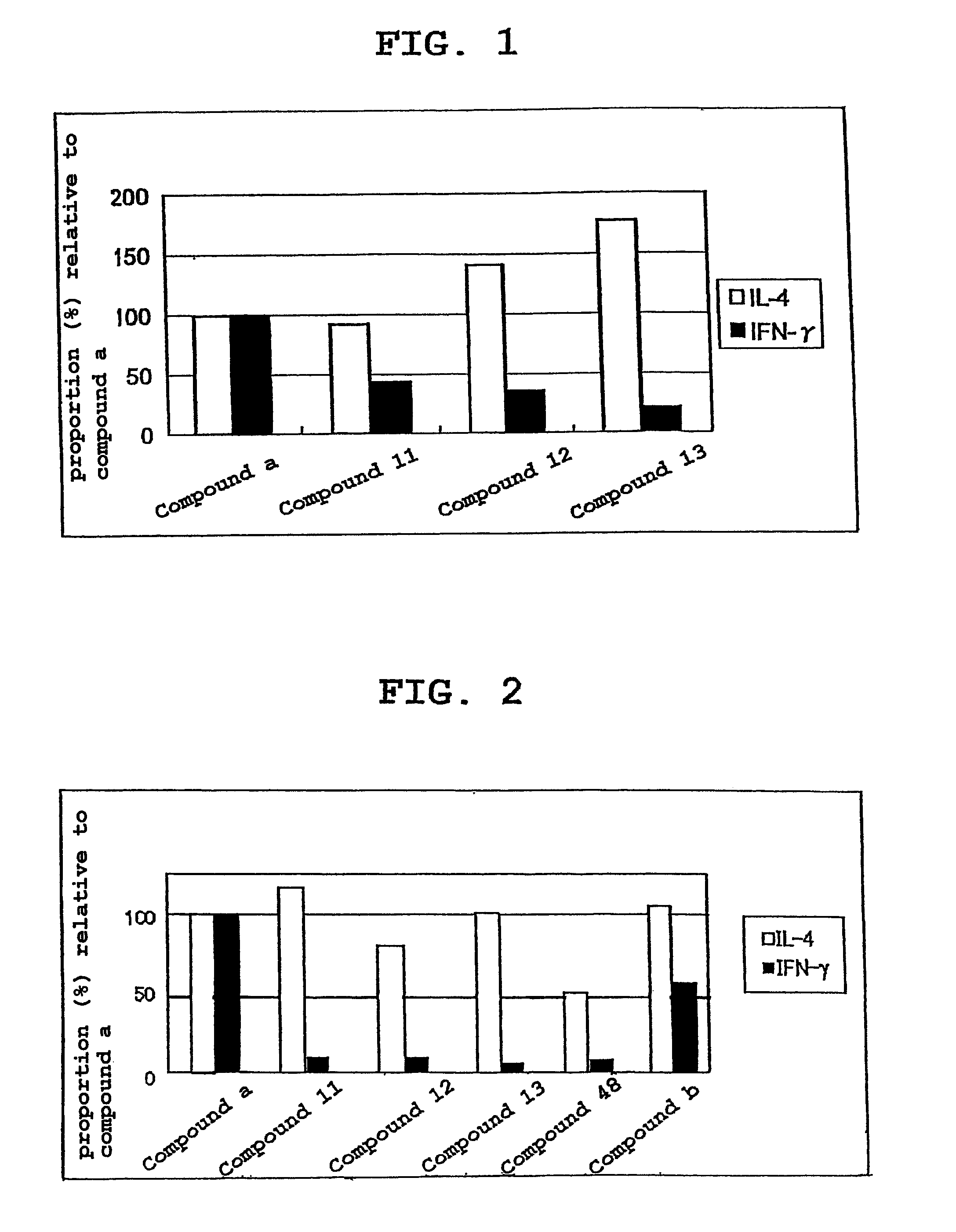Glycolipid and use thereof
a glycolipid and glycolipid technology, applied in the field of glycolipids, can solve the problems of lack of therapeutic effect on autoimmune diseases, short activation time of nkt cells, small amount of il-4 produced, etc., and achieve the effects of improving the stability of the complex, reducing the risk of autoimmune diseases, and improving the polarity
- Summary
- Abstract
- Description
- Claims
- Application Information
AI Technical Summary
Benefits of technology
Problems solved by technology
Method used
Image
Examples
example 1
(2S,3S,4R)-1-(α-D-galactopyranosyloxy)-2-(p-toluenesulfonylamino)-3,4-octadecanediol (Compound 11)
(1) Synthesis of a Compound Represented by the Following Formula (B1)
[0072]
[0073]To a solution of commercially available phytosphingosine (6.81 g, 21.4 mmol, manufactured by Degussa Cosmoferm B.V.) in dichloromethane-2,6-lutidine (1:1, 500 mL) was added tert-butyldimethylsilyl trifluoromethanesulfonate (29.5 mL, 128 mmol) under ice-cooling. The mixture was stirred at room temperature for 24 hr, and the reaction was stopped by adding methanol (10 mL). After stirring for 1 hr, the mixture was concentrated under reduced pressure. The residue was purified by silica gel column chromatography (300 g, hexane-ethyl acetate=30:1) to give compound (B1) (11.4 g, 81%) as a colorless oil.
[0074]nD17=1.4604
[0075][α]D17=−2.69 (c=1.05, CHCl3) IR (film): νmax=3400 (w, NH), 3320 (w, NH), 1255 (s, tBu, Si—CH3), 1090 (br. s, C—O), 835 (s), 775 (s) cm−1
[0076]1H NMR (500 MHz, CDCl3, 25° C.): δ=3.82 (dd, 3JH,...
example 2
(2S,3S,4R)-1-(α-D-galactopyranosyloxy)-2-(o-toluenesulfonylamino)-3,4-octadecanediol (Compound 12)
(1) Synthesis of a Compound Represented by the Following Formula (G2)
[0120]
[0121]In the same manner as in Example 1 except that o-toluenesulfonyl chloride instead of p-toluenesulfonyl chloride was used for compound (F1), compound (G2) was obtained as a colorless oil.
[0122]nD16=1.5185
[0123][α]D16=+1.72 (c=0.58, CHCl3) IR (film): νmax=3280 (br. m, NH), 1600 (br. w, aromat.), 1495 (m, aromat.), 1335 (br. m, SO2), 1250 (m, tBu, Si—CH3), 1160 (m, SO2), 1100 (br. s, C—O), 1055 (br. s, C—O), 835 (br. s), 780 (m), 695 (s) cm−1
[0124]1H NMR (500 MHz, CDCl3, 25° C.): δ=7.97 (dd, 3JH,H=8.0, 4JH,H=1.5 Hz, 1H, aromat. H), 7.39-7.19 (m, 23H, aromat. H×3, Bn-aromat. H×20), 5.60 (d, 3JH,H=5.0 Hz, 1H, NH), 4.90 (d, 3JH,H=11.5 Hz, 1H, Bn-H), 4.80 (d, 3JH,H=12.0 Hz, 1H, Bn-H), 4.77 (d, 3JH,H=12.0 Hz, 1H, Bn-H), 4.72 (d, 3JH,H=12.0 Hz, 1H, Bn-H), 4.64 (d, 3JH,H=12.0 Hz, 1H, Bn-H), 4.63 (d, 3JH,H=4.0 Hz, 1H...
example 3
(2S,3S,4R)-1-(α-D-galactopyranosyloxy)-2-(m-toluenesulfonylamino)-3,4-octadecanediol (Compound 13)
(1) Synthesis of a Compound Represented by the Following Formula (G3)
[0137]
[0138]In the same manner as in Example 1 except that m-toluenesulfonyl chloride instead of p-toluenesulfonyl chloride was used for compound (F1), compound (G3) was obtained as a colorless oil.
[0139]nD13=1.5172
[0140][α]D16=+6.41 (c=0.65, CHCl3) IR (film): νmax=3260 (br. m, NH), 1600 (w, aromat.), 1495 (m, aromat.), 1340 (m, SO2), 1250 (s, tBu, Si—CH3), 1160 (m, SO2), 1100 (br. s, C—O), 1055 (br. s, C—O), 835 (s), 780 (s), 735 (br. m), 700 (s) cm−1
[0141]1H NMR (500 MHz, CDCl3, 25° C.): δ=7.70 (d, 3JH,H=7.5 Hz, 1H, aromat. H), 7.68 (s, 1H, aromat. H), 7.39 (br. d, 3JH,H=7.5 Hz, 1H, aromat. H), 7.37-7.23 (m, 20H, Bn-aromat. H×20), 7.23 (t, 3JH,H=7.5 Hz, 1H, aromat. H), 5.70 (d, 3JH,H=5.0 Hz, 1H, NH), 4.90 (d, 3JH,H=11.5 Hz, 1H, Bn-H), 4.86 (d, 3JH,H=12.0 Hz, 1H, Bn-H), 4.78 (d, 3JH,H=12.0 Hz, 1H, Bn-H), 4.73 (d, 3JH...
PUM
 Login to View More
Login to View More Abstract
Description
Claims
Application Information
 Login to View More
Login to View More - R&D
- Intellectual Property
- Life Sciences
- Materials
- Tech Scout
- Unparalleled Data Quality
- Higher Quality Content
- 60% Fewer Hallucinations
Browse by: Latest US Patents, China's latest patents, Technical Efficacy Thesaurus, Application Domain, Technology Topic, Popular Technical Reports.
© 2025 PatSnap. All rights reserved.Legal|Privacy policy|Modern Slavery Act Transparency Statement|Sitemap|About US| Contact US: help@patsnap.com



